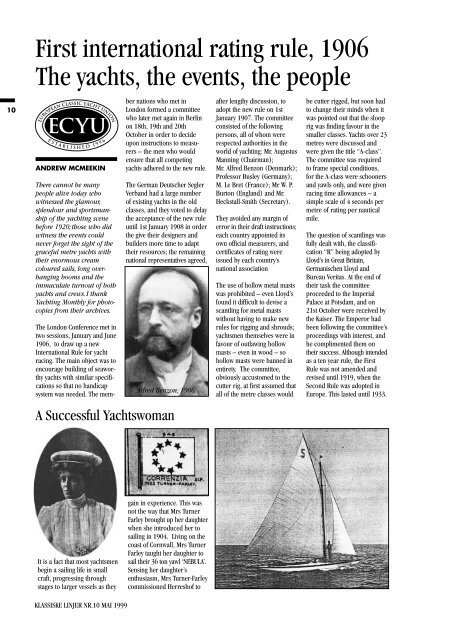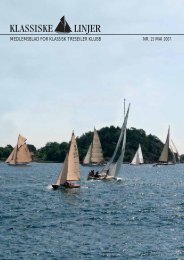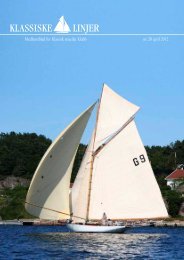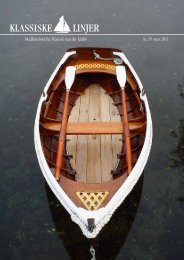Klassiske Linjer nr 10 1999 - Klassisk Treseiler Klubb
Klassiske Linjer nr 10 1999 - Klassisk Treseiler Klubb
Klassiske Linjer nr 10 1999 - Klassisk Treseiler Klubb
You also want an ePaper? Increase the reach of your titles
YUMPU automatically turns print PDFs into web optimized ePapers that Google loves.
<strong>10</strong><br />
First international rating rule, 1906<br />
The yachts, the events, the people<br />
ANDREW MCMEEKIN<br />
There cannot be many<br />
people alive today who<br />
witnessed the glamour,<br />
splendour and sportsmanship<br />
of the yachting scene<br />
before 1920; those who did<br />
witness the events could<br />
never forget the sight of the<br />
graceful metre yachts with<br />
their enormous cream<br />
coloured sails, long overhanging<br />
booms and the<br />
immaculate turnout of both<br />
yachts and crews. I thank<br />
Yachting Monthly for photocopies<br />
from their archives.<br />
The London Conference met in<br />
two sessions, January and June<br />
1906, to draw up a new<br />
International Rule for yacht<br />
racing. The main object was to<br />
encourage building of seaworthy<br />
yachts with similar specifications<br />
so that no handicap<br />
system was needed. The mem-<br />
It is a fact that most yachtsmen<br />
begin a sailing life in small<br />
craft, progressing through<br />
stages to larger vessels as they<br />
KLASSISKE LINJER NR.<strong>10</strong> MAI <strong>1999</strong><br />
ber nations who met in<br />
London formed a committee<br />
who later met again in Berlin<br />
on 18th, 19th and 20th<br />
October in order to decide<br />
upon instructions to measurers<br />
– the men who would<br />
ensure that all competing<br />
yachts adhered to the new rule.<br />
The German Deutscher Segler<br />
Verband had a large number<br />
of existing yachts in the old<br />
classes, and they voted to delay<br />
the acceptance of the new rule<br />
until 1st January 1908 in order<br />
the give their designers and<br />
builders more time to adapt<br />
their resources; the remaining<br />
national representatives agreed,<br />
Alfred Benzon, 1906.<br />
A Successful Yachtswoman<br />
gain in experience. This was<br />
not the way that Mrs Turner<br />
Farley brought up her daughter<br />
when she introduced her to<br />
sailing in 1904. Living on the<br />
coast of Cornwall, Mrs Turner<br />
Farley taught her daughter to<br />
sail their 36 ton yawl ‘NEBULA’.<br />
Sensing her daughter’s<br />
enthusiasm, Mrs Turner-Farley<br />
commissioned Herreshof to<br />
after lengthy discussion, to<br />
adopt the new rule on 1st<br />
January 1907. The committee<br />
consisted of the following<br />
persons, all of whom were<br />
respected authorities in the<br />
world of yachting: Mr. Augustus<br />
Manning (Chairman);<br />
Mr. Alfred Benzon (Denmark);<br />
Professor Busley (Germany);<br />
M. Le Bret (France); Mr W. P.<br />
Burton (England) and Mr.<br />
Heckstall-Smith (Secretary).<br />
They avoided any margin of<br />
error in their draft instructions;<br />
each country appointed its<br />
own official measurers, and<br />
certificates of rating were<br />
issued by each country’s<br />
national association<br />
The use of hollow metal masts<br />
was prohibited – even Lloyd’s<br />
found it difficult to devise a<br />
scantling for metal masts<br />
without having to make new<br />
rules for rigging and shrouds;<br />
yachtsmen themselves were in<br />
favour of outlawing hollow<br />
masts – even in wood – so<br />
hollow masts were banned in<br />
entirety. The committee,<br />
obviously accustomed to the<br />
cutter rig, at first assumed that<br />
all of the metre classes would<br />
be cutter rigged, but soon had<br />
to change their minds when it<br />
was pointed out that the sloop<br />
rig was finding favour in the<br />
smaller classes. Yachts over 23<br />
metres were discussed and<br />
were given the title “A-class”.<br />
The committee was required<br />
to frame special conditions,<br />
for the A-class were schooners<br />
and yawls only, and were given<br />
racing time allowances – a<br />
simple scale of 4 seconds per<br />
metre of rating per nautical<br />
mile.<br />
The question of scantlings was<br />
fully dealt with, the classification<br />
“R” being adopted by<br />
Lloyd’s in Great Britain,<br />
Germanischen Lloyd and<br />
Bureau Veritas. At the end of<br />
their task the committee<br />
proceeded to the Imperial<br />
Palace at Potsdam, and on<br />
21st October were received by<br />
the Kaiser. The Emperor had<br />
been following the committee’s<br />
proceedings with interest, and<br />
he complimented them on<br />
their success. Although intended<br />
as a ten year rule, the First<br />
Rule was not amended and<br />
revised until 1919, when the<br />
Second Rule was adopted in<br />
Europe. This lasted until 1933.






